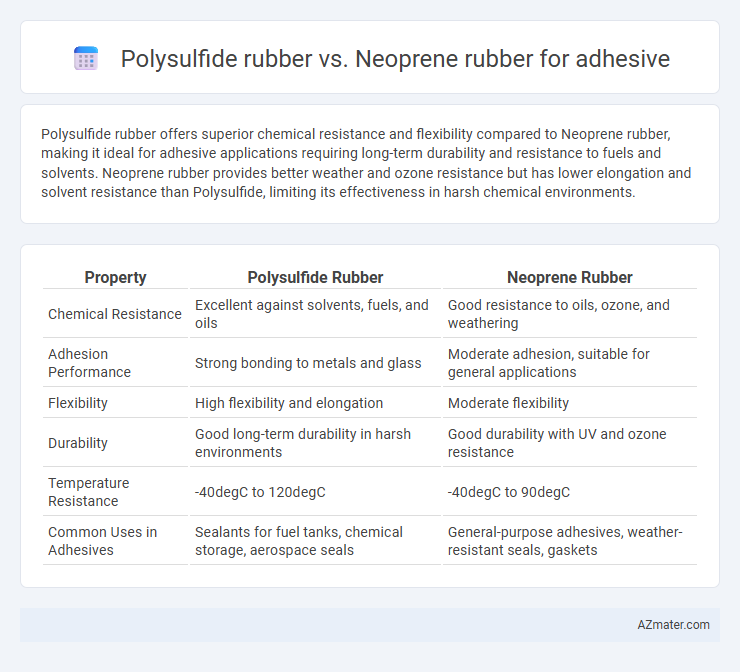Polysulfide rubber offers superior chemical resistance and flexibility compared to Neoprene rubber, making it ideal for adhesive applications requiring long-term durability and resistance to fuels and solvents. Neoprene rubber provides better weather and ozone resistance but has lower elongation and solvent resistance than Polysulfide, limiting its effectiveness in harsh chemical environments.
Table of Comparison
| Property | Polysulfide Rubber | Neoprene Rubber |
|---|---|---|
| Chemical Resistance | Excellent against solvents, fuels, and oils | Good resistance to oils, ozone, and weathering |
| Adhesion Performance | Strong bonding to metals and glass | Moderate adhesion, suitable for general applications |
| Flexibility | High flexibility and elongation | Moderate flexibility |
| Durability | Good long-term durability in harsh environments | Good durability with UV and ozone resistance |
| Temperature Resistance | -40degC to 120degC | -40degC to 90degC |
| Common Uses in Adhesives | Sealants for fuel tanks, chemical storage, aerospace seals | General-purpose adhesives, weather-resistant seals, gaskets |
Overview of Polysulfide and Neoprene Rubber Adhesives
Polysulfide rubber adhesives are known for their excellent chemical resistance, flexibility, and durability, making them ideal for sealing applications in aerospace, construction, and automotive industries. Neoprene rubber adhesives offer strong adhesion to a variety of substrates, good weather resistance, and moderate flexibility, commonly used in electrical insulation, gaskets, and marine applications. Both adhesives provide effective sealing and bonding, but polysulfide excels in fuel and solvent resistance while neoprene is preferred for general-purpose and indoor environments.
Key Chemical Properties Comparison
Polysulfide rubber exhibits superior chemical resistance to solvents, fuels, and oils due to its high sulfur content and flexible polysulfide bonds, making it ideal for adhesive applications requiring durability under harsh environments. Neoprene rubber, characterized by its chloroprene monomers, offers excellent resistance to ozone, weathering, and moderate chemical exposure, with better tensile strength but lower elongation compared to polysulfide. The key chemical property distinction lies in polysulfide's enhanced impermeability and resistance to oxidative degradation, while neoprene provides balanced chemical resilience and mechanical stability for diverse adhesive uses.
Adhesion Performance on Various Substrates
Polysulfide rubber exhibits superior adhesion performance on non-porous substrates such as glass, metal, and ceramics due to its excellent chemical resistance and flexibility. Neoprene rubber provides strong adhesion with moderate elasticity, making it suitable for bonding metals, wood, and certain plastics, though it may underperform on glass compared to polysulfide. For applications requiring durable, waterproof seals on diverse substrates, polysulfide adhesives often outperform neoprene adhesives in resisting environmental degradation and maintaining bond strength.
Durability and Weather Resistance
Polysulfide rubber exhibits superior durability and weather resistance compared to neoprene rubber, making it ideal for adhesives exposed to harsh environmental conditions. Its excellent resistance to ozone, UV radiation, and chemical exposure ensures longer-lasting seals and joints, especially in marine and industrial applications. Neoprene rubber offers moderate durability but is less effective against prolonged weathering and chemical degradation, limiting its use in extreme environments.
Flexibility and Elasticity Differences
Polysulfide rubber exhibits superior flexibility and elasticity compared to neoprene rubber, making it ideal for applications requiring extensive elongation and recovery, such as sealants and flexible adhesives. Neoprene rubber offers moderate flexibility with enhanced chemical and weather resistance, suitable for less dynamic bonding environments. The molecular structure of polysulfide allows greater chain mobility, resulting in enhanced stretchability and rebound resilience over neoprene elastomer.
Chemical and Oil Resistance
Polysulfide rubber exhibits superior chemical resistance, especially against solvents, fuels, and oils, making it ideal for adhesive applications requiring durability in harsh environments. Neoprene rubber offers moderate resistance to oils and chemicals but tends to degrade faster when exposed to strong solvents and petroleum-based fluids. For adhesives exposed to aggressive chemical and oil exposure, polysulfide rubber ensures enhanced longevity and performance compared to neoprene.
Application Methods and Ease of Use
Polysulfide rubber adhesives require careful mixing of multiple parts and longer curing times, making the application process more complex but providing superior chemical resistance and flexibility for sealants in construction and aerospace. Neoprene rubber adhesives offer simpler one-part formulations or easier mixing, allowing faster application with good initial tack and bond strength, ideal for automotive and marine uses. Polysulfide demands precise environmental control during curing, whereas neoprene is more forgiving and user-friendly for general-purpose bonding.
Cost and Availability Analysis
Polysulfide rubber is generally more expensive than neoprene rubber due to its complex synthesis and specialized applications in high-performance sealants and adhesives. Neoprene rubber offers greater availability as it is widely produced and used across various industries, resulting in lower costs and easier procurement. Cost-efficiency and broader market access make neoprene rubber a preferred choice for general adhesive applications, whereas polysulfide rubber's cost is justified in niche scenarios requiring superior chemical and weather resistance.
Typical Industrial and Commercial Uses
Polysulfide rubber adhesives are widely used in aerospace, marine, and construction industries due to their excellent chemical resistance, flexibility, and strong adhesion to glass, metal, and concrete surfaces. Neoprene rubber adhesives excel in automotive, electronics, and HVAC applications owing to their durability, weather resistance, and ability to bond various substrates including metals, fabrics, and plastics. Both adhesives are integral in sealing and bonding applications requiring water resistance and mechanical strength, but polysulfide tends to outperform in fuel and solvent exposure environments.
Choosing the Right Adhesive for Your Project
Polysulfide rubber offers excellent chemical resistance and flexibility, making it ideal for sealing and bonding in construction and aerospace applications where durability and weather resistance are critical. Neoprene rubber provides superior resistance to oils, ozone, and aging, making it suitable for automotive and marine adhesive projects that require strong adhesion and resilience under harsh conditions. Selecting the right adhesive depends on environmental exposure, chemical compatibility, and mechanical stress, with polysulfide suited for flexible, long-lasting seals, while neoprene excels in elastic, weatherproof bonds.

Infographic: Polysulfide rubber vs Neoprene rubber for Adhesive
 azmater.com
azmater.com